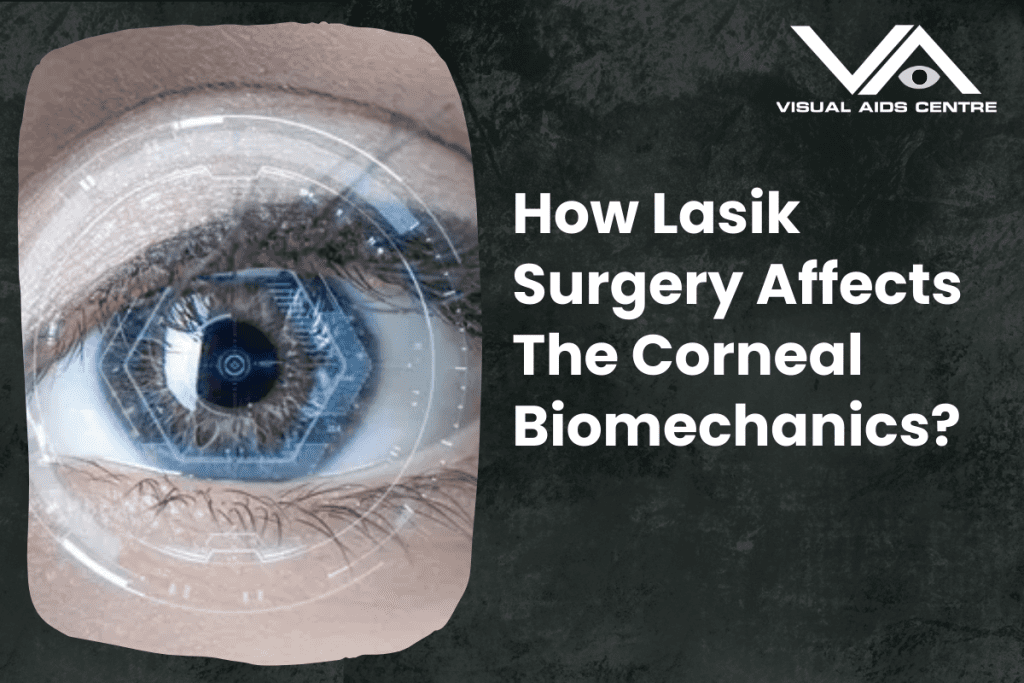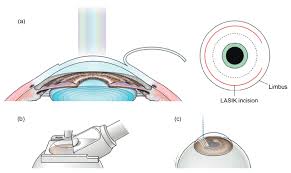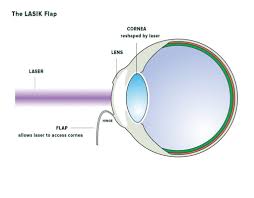Table of Contents
ToggleLASIK surgery alters the cornea’s biomechanical stability by reshaping and thinning its structure to improve vision.
While effective for correcting refractive errors, these changes can have significant implications for the cornea’s strength and flexibility.

Understanding Corneal Biomechanics
The cornea is a complex and resilient structure that plays a vital role in maintaining the clarity and focusing power of the eye. Its unique biomechanical properties ensure it withstands external factors, such as intraocular pressure (IOP) and environmental forces. These properties include:
- Integrity of Stromal Collagen Fibres: The interwoven collagen fibres provide the cornea with its strength and elasticity.
- Corneal Thickness and Curvature: The architecture of the cornea contributes to its refractive capability and mechanical stability.
- Viscoelasticity: The ability to adjust and recover shape under stress is critical for normal functioning.
LASIK surgery modifies these intrinsic properties significantly, leading to structural changes whose implications require careful consideration.
How Does LASIK Surgery Work?
LASIK (Laser-Assisted in Situ Keratomileusis) reshapes the cornea to correct refractive errors like myopia, hyperopia, and astigmatism. An ophthalmic surgeon uses a femtosecond laser or microkeratome to create a corneal flap. The underlying stromal tissue is then reshaped using an excimer laser, after which the flap is replaced. While this process delivers sharp vision, it fundamentally alters the biomechanical integrity of the cornea.
Effects of LASIK Surgery on Corneal Biomechanics
1. Reduction in Corneal Thickness
LASIK involves the removal of stromal tissue to achieve the desired refractive correction. This thinning of the cornea directly reduces its mechanical strength. Studies show that the degree of biomechanical weakening is proportional to the amount of tissue removed. The greater the level of correction, the more significant the reduction in corneal stability.
- Biomechanical Weakening Post-Surgery: Post-LASIK corneas are less capable of resisting changes in IOP. This can have serious implications for patients predisposed to conditions like keratoconus or ectasia.
2. Disruption of Collagen Fibres
The stromal layer of the cornea comprises collagen fibres arranged in a lattice structure that provides tensile strength. During LASIK:
- Cutting the flap severs some collagen fibres, disrupting the biomechanical equilibrium.
- The excimer laser alters the alignment of these fibres in the residual stromal bed.
This disruption compromises the cornea’s ability to handle stress, further weakening its biomechanical resilience.
3. Impact on Corneal Hysteresis
Corneal hysteresis refers to the cornea’s viscoelastic response to pressure. It represents the cornea’s ability to absorb and dissipate energy. Post-LASIK, there is a measurable reduction in corneal hysteresis, which correlates with potential vulnerability to ocular stress and diseases.
4. Changes in Corneal Shape and Stability
By altering the curvature of the cornea, LASIK creates a biomechanical imbalance:
- Redistribution of Stress: The reshaped cornea experiences an uneven distribution of stress, particularly in regions close to the surgery site.
- Risk of Ectasia: Significant biomechanical weakening can lead to corneal ectasia, a progressive condition where the cornea bulges outward, resulting in distorted vision.
5. Loss of Flap-Related Structural Integrity
The creation of the flap itself reduces corneal stability. Flap thickness and diameter play a vital role:
- Thicker flaps cause more disruption to the stromal architecture.
- Larger flaps increase the overall biomechanical impact.
This residual weakness raises concerns, especially in cases of post-surgery trauma.
Long-Term Biomechanical Implications
Although LASIK surgery provides immediate visual benefits, it’s critical to consider its long-term impact. The weakened cornea may face challenges, such as:
- Delayed Onset of Ectasia: This can manifest months or even years after LASIK in rare cases.
- Difficulty with Lens Pressure: Wearing contact lenses post-LASIK may put excess pressure on the corneal surface, potentially aggravating biomechanical weakness.
- Limited Suitability for Future Procedures: Thinner and weaker corneas may restrict the possibility of undergoing additional corrective procedures, such as enhancement surgeries or cataract operations.
Variables Influencing Biomechanical Changes Post-LASIK
The degree to which LASIK affects corneal biomechanics varies based on several factors, including:
- Thickness of Residual Stromal Bed (RSB): Maintaining sufficient stromal thickness post-surgery is crucial for minimising biomechanical weakness. Most surgeons recommend leaving a minimum of 250 microns of RSB.
- Size of Ablation Zone: Larger treatment zones may lead to greater biomechanical changes.
- Pre-operative Corneal Condition: Patients with thinner corneas or asymmetrical curvature are at higher risk of complications.
Understanding these factors allows ophthalmologists to evaluate patient suitability more effectively and mitigate potential issues.
Advanced Techniques to Minimise Biomechanical Alterations
Innovations in laser surgery techniques have emerged to address concerns regarding biomechanical weakening:
- Small Incision Lenticule Extraction (SMILE):
- Unlike LASIK, SMILE does not require a flap, significantly reducing disruption to stromal collagen.
- It preserves biomechanical strength more effectively and lowers the risk of ectasia.
- Wavefront-Guided LASIK: By using detailed mapping of the eye’s unique refractive errors, this technique reduces the extent of tissue removal and ensures precise reshaping, thus minimising mechanical alteration.
- Customised Ablation Profiles: Tailoring the ablation process based on individual corneal properties helps to optimise biomechanics post-surgery.
- Corneal Cross-Linking (CXL): This adjunct procedure involves strengthening the corneal structure using riboflavin and UV light. CXL is particularly useful in those with pre-existing biomechanical weaknesses.
Importance of Pre-Operative Assessment
A thorough pre-operative evaluation is critical in identifying and mitigating risks. Precise measurements of parameters such as:
- Pachymetry (corneal thickness)
- Topography (corneal shape)
- Corneal hysteresis and resistance factor
These tests help surgeons assess patient suitability, determine the optimal technique, and ensure minimal biomechanical compromise.
Patient Awareness and Post-Operative Care
Patients must be made aware of the possible biomechanical effects of LASIK and should follow proper post-surgery care:
- Regular Monitoring: Periodic eye checks are crucial to identify any biomechanical issues early.
- Protect the Eyes: Avoid activities that may expose the eyes to physical trauma, especially in the months following surgery.
- Report Any Changes: Any abnormalities in vision, such as blurred or distorted vision, should be reported to an ophthalmologist immediately.
Final Thoughts
LASIK surgery is a life-changing procedure for millions of patients worldwide. However, its impact on the corneal biomechanical structure must not be overlooked. By understanding these effects, eye surgeons can tailor procedures to individual patients, ensuring optimal outcomes while preserving corneal integrity.
For patients, conducting thorough research and having open discussions with their surgeon about potential risks are vital steps to making informed decisions. As advancements in laser technology continue, the future holds promise for improved methods that balance visual correction with biomechanical preservation.













